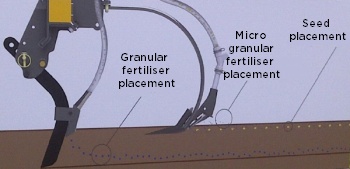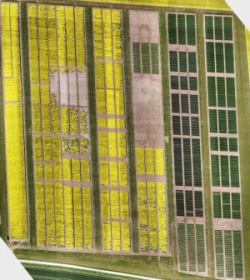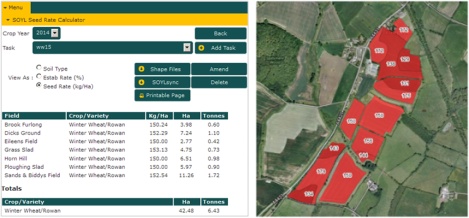SOYL Newsletter July 2014
1. Yield improvements with early phosphate
Trials have shown positive yield responses in oilseed rape when phosphate is applied at the time of drilling. With the new season just around the corner, now is a good time to consider including early phosphate applications with your seed.
The application is usually performed with combine drills, placing a small amount of phosphate next to the seed. Typical application rates are around 20kg/ha of phosphate as micro granules, or 50-80kg/ha applied as granular products.

Soil levels must be maintained at index 2. If less than a maintenance application of phosphate is applied at drilling, soil levels will reduce, resulting in longer term yield losses instead of the intended gains.
The amount of phosphate applied at drilling can be deducted from the total crop requirement and the balance applied as a normal variable application of phosphate later in the season. Applying 20kg with the drill, therefore, would also mean that 20kg is deducted from the overall requirement.
Trials have also shown that broadcast fertiliser applied at or just before drilling can give similar advantages to phosphate applied with the drill. One kg of phosphate placed near the seed is just as beneficial as one kg of broadcast phosphate.
To learn more about this and other precision crop production techniques, call 01635 204190 or email This email address is being protected from spambots. You need JavaScript enabled to view it.
2. A day in the life of a UAV
The revolutionary capabilities of unmanned aerial vehicle (UAV) technology have the potential to make a positive impact on farm management and efficiency. Use of this technology is becoming more widespread as this potential is recognised.
SOYLsight, the UAV technology used by SOYL to identify crop performance issues, has been put through its paces over the last few months by David Whattoff, research and development manager.

Work begins well before the UAV takes to the air. The first stage is a consultation with the farmer to precisely identify their requirements; it is vital that the UAV collects the correct data. Following this, a robust survey is undertaken to ensure it is safe to fly each field. With plans confirmed, the flight itself is a relatively short part of the overall operation. The bulk of the work comes next when the data is interpreted and analysed to form the basis for recommendations to the grower.
But the planning and processing is definitely worth it; the results are impressive. Using the colour camera and flying at a height of 90 metres, David has mapped a customer’s fields to show the exact location of patches of blackgrass. “This information has then been used to create a variable rate treatment zone” he says. But he does offer a word of caution “To make the best use of the UAV, it needs to be used as part of a cultural control strategy and it is vital that you talk to your agronomist to make a comprehensive plan.”
There is also the opportunity to use the multi-spectral camera to look at various crop indices, such as the chlorophyll index, which has a very close relationship to the nitrogen value of the plant. Alternatively, red edge NDVI, which uses a narrower spectrum of light, can be used to quantify growth stages
David also works closely with the trials teams, “We use the UAV to look at disease management, fungicide efficacy and PGR programmes. Once the flight path has been set, we can then fly exactly the same path through the season allowing us to look at precise growth patterns, and compare results through the year.”
3. Post harvest soil sampling begins
The early start to this season’s harvest has allowed soil sampling to begin and numbers are already well ahead of this time last year.
Managing SOYL’s nationwide team of over 40 samplers is a big challenge but 20 years of experience and an expert office based logistics team ensure fast responses to meet growers’ needs.
Over the last two years, we have increased the level of traceability and now use telemetry to track every infield movement, giving a full audit of our precision sampling service.
To confirm your sampling requirements, please call Rebecca Tickle on 01635 204190.
4. Boost crops with soil survey results
Comprehensive soil surveys are being carried out now. These measure soil variation to a depth of at least 120cm and create a base for variable rate seed and variable depth cultivations.
Variable seed rate drilling results in more even plant populations and reduces crop variation by up to 50%. This is based on over 4,000 plant counts by SOYL technicians between 2009 and 2013.
There is still time to book a survey for post harvest; please call Rebecca Tickle on 01635 204190.
5. Manage variable seed rates with MySOYL
Creating and editing variable seed rate files is quick and easy with MySOYL.
With the ability to calculate and amend seed rate files for individual fields and view each seed rate across your land online, managing your business as the drilling window approaches has never been simpler.
Drilling files can then be exported as shape files or direct to your SOYLsync account.

Training on how to use MySOYL’s features is free and can be arranged with a member of the technical support team at a convenient time. To request a training session, please call 01635 204190.
MySOYL is available to all SOYL customers and is free to access. To register your interest in MySOYL, simply send your business details to This email address is being protected from spambots. You need JavaScript enabled to view it. or speak to your local SOYL representative.
6. Round the clock support at harvest
We know that growers are out in the field at all times of the day and night during this busy period. To ensure you get the answers you need, when you need them, our office numbers divert to a 24/7 call answering service out of hours, enabling support calls to be logged at any time of the day or week. Calls received will then be distributed to a wide group of key, experienced staff who will quickly ring you back to resolve any issues, allowing you to get back to the job in hand as soon as possible.
Don’t forget you can follow us on Twitter @SOYLprecision for regular updates on soils, nutrients, machinery and GPS.










